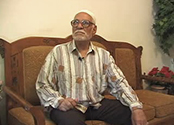Interview with Qasim Muḥammad Dirbāj
| Biography: | The interview was recorded with Qasim Muḥammad Dirbāj, male, born in 1925 in Qadas, Palestine. |
|---|---|
| Interviewer: | Mughrabī, Bushrá |
| Interviewee: | Dirbāj, Qasim Muḥammad |
| Place of Origin: | Qadas |
| In Collection: | POHA, Al-Nakba Collection |
| Interview Audio/Video: | |
| Format: | video |
| Duration: | 01:51:03 |
| Language: | Arabic |
| Permanent Link: | http://hdl.handle.net/123456789/4479 |
| Subjects: | |
| Significant Figures: | al-Dʹhaynī, ʻAbdullāh (Shaykh); Dirbāj, Muḥammad (Mayor); al-Sūqīyah,ʻAqlah (Mayor); Khanāfir, Saʻīd (Village leader); al-Mīzārī, ‘Abd al-Raḥmān (Village leader); Khalīl, Ḥasan (Wounded); al-As‘ad, Aḥmad (Village leader); al-Ḥusayn, Kāmil (Village leader); Dirbāj, Aḥmad (Resistance fighter leader); Ḥusayn, Muḥammad (Resistance fighter); Kinyār, Muḥammad Qāsim (Resistance fighter); al-‘Abd, Qāsim (Wounded); Zughayb, Muḥammad (Lebanese Army commander); al-As‘ad, Aḥmad (Leader). |
| Families: | Mārdīnī; al-Mārdīnī; Bazzī; Farḥāt; Kinyār; Dirbaj; al-Sūqīyah; ‘Īsá. |
| Landmarks-Places of Worship: | al-Nabī Yūshaʻ (Maqām); al-Nabī Shuʻayb (Maqām); Umm Yūshaʻ (Maqām). |
| Landmarks-Lakes, Rivers: | ‘Ayn Qadas (Water resource). |
| Table of Contents: |
Socio-economic conditions in the villagwe. (@ 00:00:00) Land and identity in Palestine. (@ 00:08:59) Socio-economic dynamics during the British rule. (@ 00:25:40) Social dynamics in the village. (@ 00:32:27) Marriage celebrations in Palestine. (@ 00:42:14) Community life in Qadas. (@ 00:53:38) Political turmoil and military activity in the village. (@ 00:59:44) War time and military occupation. (@ 01:09:7) Violence, battles and armed resistance. (@ 01:21:13) Military occupation and hopes for the future. (@ 01:33:30) |
Table of Contents:
- Socio-economic conditions in the villagwe. (@ 0:00)
- Land and identity in Palestine. (@ 8:59)
- Socio-economic dynamics during the British rule. (@ 25:40)
- Social dynamics in the village. (@ 32:27)
- Marriage celebrations in Palestine. (@ 42:14)
- Community life in Qadas. (@ 53:38)
- Political turmoil and military activity in the village. (@ 59:44)
- War time and military occupation. (@ 69:7)
- Violence, battles and armed resistance. (@ 81:13)
- Military occupation and hopes for the future. (@ 93:30)

